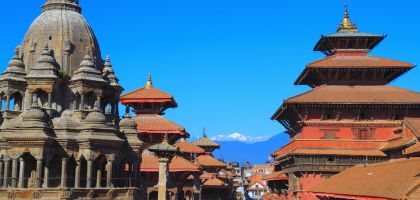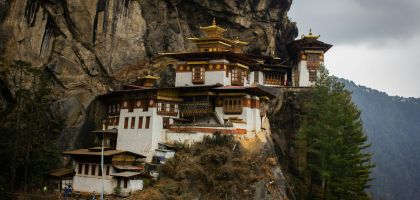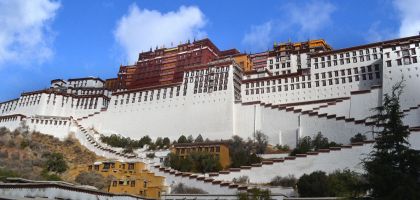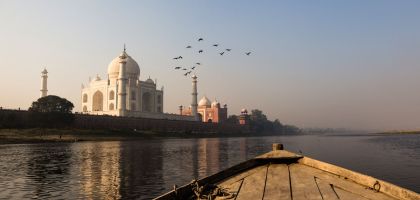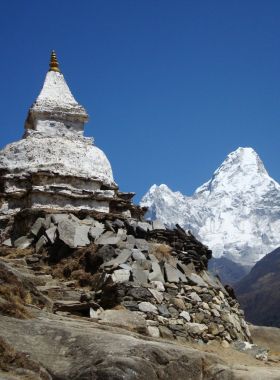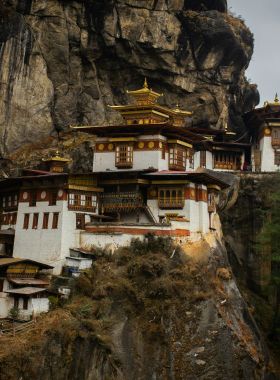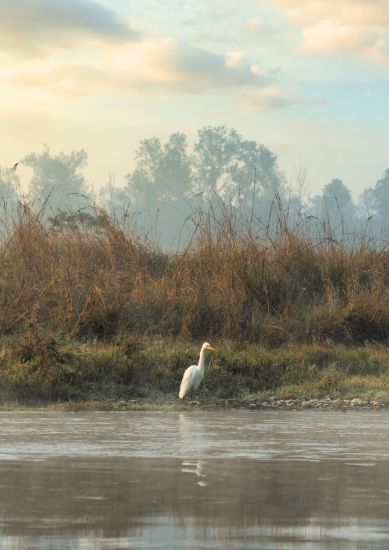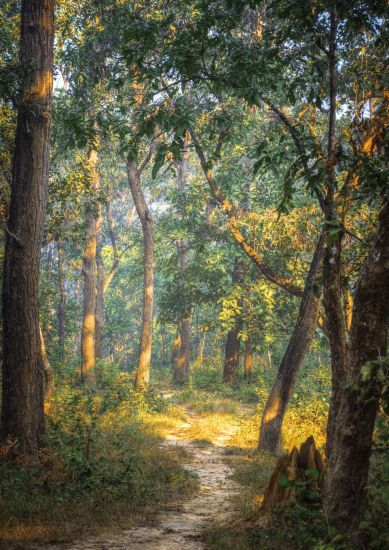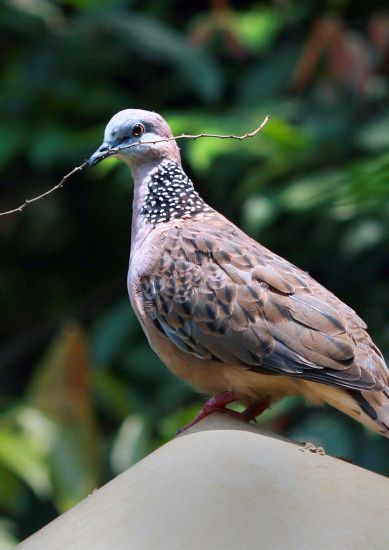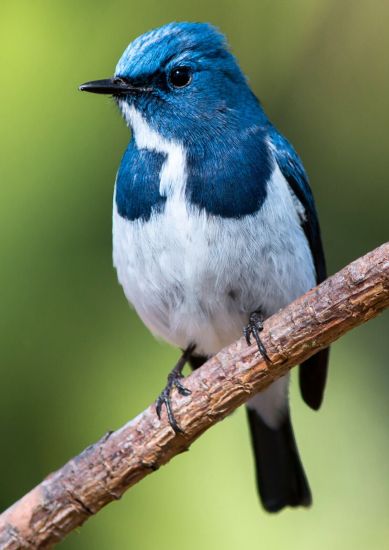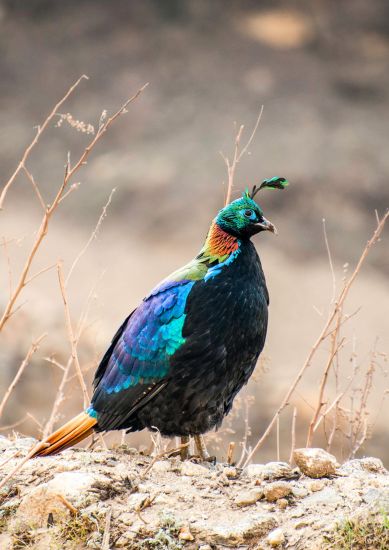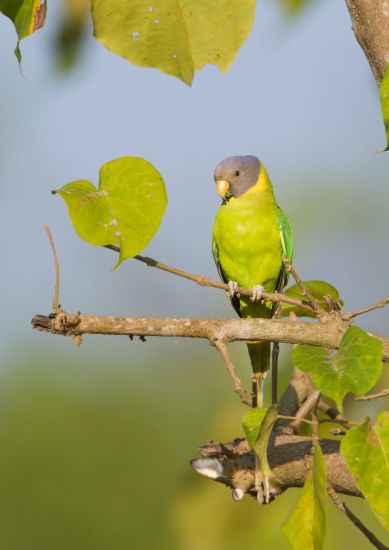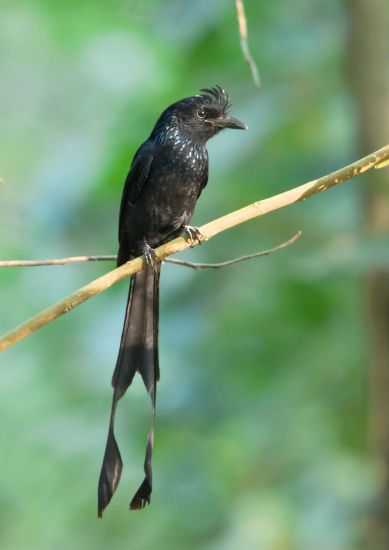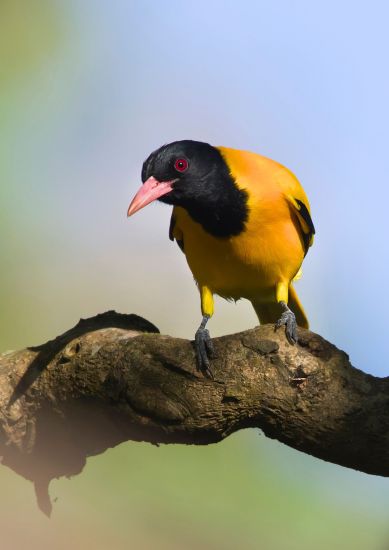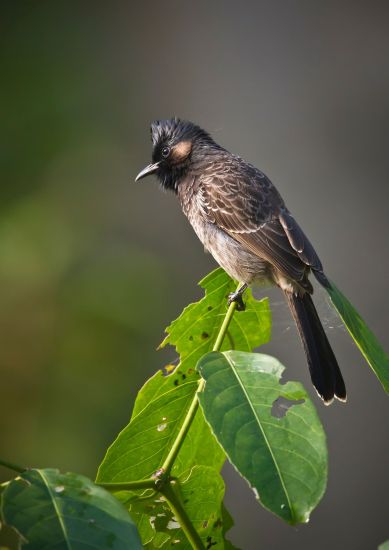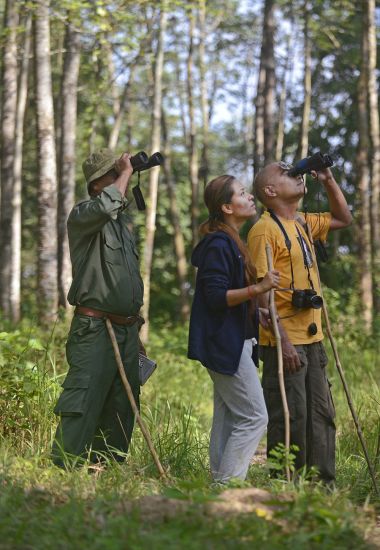Nepal Birding Tour
11 Days / Nepal
Activity
Difficulty Level
Destinations
Trip Start / End
Accommodation
Travel Style
Best time to travel
Personalized Travel Advice

Dev Raj Nepal
+977 9851096523
Detailed Itinerary
01
DAY
01
Your Nepal Birdwatching Tour begins when you arrive at Tribhuvan International Airport, where we will warmly welcome you and transfer you to your hotel in Kathmandu. The rest of the day is free to relax after your flight. You may stroll around Thamel, a lively area filled with cafés, shops, and restaurants.
In the evening, our birding guide will brief you about the upcoming days, discussing key birding destinations, species to look out for, and travel logistics. Depending on your arrival time, you may also explore the nearby Garden of Dreams, a peaceful green oasis in the city, where common urban species such as House Sparrow, Oriental Magpie Robin, and Black Kite can be spotted.
Arrival Kathmandu
Your Nepal Birdwatching Tour begins when you arrive at Tribhuvan International Airport, where we will warmly welcome you and transfer you to your hotel in Kathmandu. The rest of the day is free to relax after your flight. You may stroll around Thamel, a lively area filled with cafés, shops, and restaurants.
In the evening, our birding guide will brief you about the upcoming days, discussing key birding destinations, species to look out for, and travel logistics. Depending on your arrival time, you may also explore the nearby Garden of Dreams, a peaceful green oasis in the city, where common urban species such as House Sparrow, Oriental Magpie Robin, and Black Kite can be spotted.
02
DAY
02
After an early breakfast, embark on a full-day birding excursion to Phulchowki Hill, the most rewarding birdwatching site in the Kathmandu Valley. Rising to 2,760 meters, this forested hill is part of Nepal’s Important Bird Areas (IBA) network and has recorded over 300 bird species, a remarkable diversity within such a compact area.
The ascent from the Godavari Botanical Garden at the base to the higher temperate forest zones reveals a stunning range of habitats, from lush subtropical woods to rhododendron-covered slopes. This elevational variety attracts an incredible mix of birds, and sightings often change with every few hundred meters of gain. In winter, many species descend to lower altitudes, making the foothills equally productive.
Expect to encounter a colorful array of species, including Spiny Babbler (Nepal’s only endemic bird), Jungle Babbler, Slender-billed Scimitar Babbler, Scaly-breasted Wren Babbler, Gray-sided Laughing-Thrush, Red-headed Laughing Thrush, Streaked Laughing-Thrush, Blue-winged Minla, Bar-throated Minla, Yellow-naped Yuhina, Orange-gorgeted Flycatcher, Mrs. Gould’s Sunbird, Nepal Sunbird, Himalayan Cutia, Hoary-throated Barwing, Fire-tailed Sunbird, Rufous-bellied Niltava, Red-billed Blue Magpie, and even the regal Himalayan Monal if you are fortunate. The forest canopy resonates with different birds, while raptors like Mountain Hawk Eagle and Black Eagle can sometimes be seen circling above.
You will enjoy a packed lunch amidst the serene natural surroundings, with opportunities to pause at different elevations for observation and photography. Return to Kathmandu in the late afternoon. Evening free to relax or any historical site in the city.
Phulchowki Hill
After an early breakfast, embark on a full-day birding excursion to Phulchowki Hill, the most rewarding birdwatching site in the Kathmandu Valley. Rising to 2,760 meters, this forested hill is part of Nepal’s Important Bird Areas (IBA) network and has recorded over 300 bird species, a remarkable diversity within such a compact area.
The ascent from the Godavari Botanical Garden at the base to the higher temperate forest zones reveals a stunning range of habitats, from lush subtropical woods to rhododendron-covered slopes. This elevational variety attracts an incredible mix of birds, and sightings often change with every few hundred meters of gain. In winter, many species descend to lower altitudes, making the foothills equally productive.
Expect to encounter a colorful array of species, including Spiny Babbler (Nepal’s only endemic bird), Jungle Babbler, Slender-billed Scimitar Babbler, Scaly-breasted Wren Babbler, Gray-sided Laughing-Thrush, Red-headed Laughing Thrush, Streaked Laughing-Thrush, Blue-winged Minla, Bar-throated Minla, Yellow-naped Yuhina, Orange-gorgeted Flycatcher, Mrs. Gould’s Sunbird, Nepal Sunbird, Himalayan Cutia, Hoary-throated Barwing, Fire-tailed Sunbird, Rufous-bellied Niltava, Red-billed Blue Magpie, and even the regal Himalayan Monal if you are fortunate. The forest canopy resonates with different birds, while raptors like Mountain Hawk Eagle and Black Eagle can sometimes be seen circling above.
You will enjoy a packed lunch amidst the serene natural surroundings, with opportunities to pause at different elevations for observation and photography. Return to Kathmandu in the late afternoon. Evening free to relax or any historical site in the city.
03
DAY
03
This morning, head north of the city for a full-day birding trip to Shivapuri National Park, a pristine protected area that forms part of the Kathmandu Valley’s northern rim. Just a short drive from the city center, Shivapuri is the youngest national park in Nepal, yet one of the most important for bird conservation. Over 300 species have been recorded here, including many forest specialists and hill-country endemics.
The park’s trails wind through oak, pine, and rhododendron forests interspersed with crystal-clear streams and open ridges that provide panoramic views of the valley below. These diverse habitats make Shivapuri an exceptional birding destination close to urban Kathmandu.
Species frequently encountered include Spotted Babbler, Chestnut-headed Tit Babbler, Bar-throated Minla, Red-billed Leiothrix, Nepal Parrotbill, White-tailed Blue Robin, White-bellied Redstart, Blue-headed Redstart, Chestnut-bellied Rock Thrush, Purple Cochoa, Tickell’s Thrush, Winter Wren, Maroon-backed Accentor, Rufous-breasted Accentor, Hodgson’s Tree Pipit, Great Barbet, Maroon Oriole, Verditer Flycatcher, Grey-hooded Warbler, Hoary Barwing, and Black Eagle soaring above the ridges. The quieter interior trails are also known for sightings of the elusive Kalij Pheasant and the vibrant Scarlet Finch during spring.
You will enjoy your packed lunch within the forest clearing, surrounded by birdsong and the tranquil atmosphere of the Himalayas’ lower slopes.
Shivapuri offers a perfect contrast to Phulchowki, slightly drier forests and open viewpoints, which help in spotting canopy birds and raptors. With patience and keen observation, birders often record over 60 species in a single day here.
Return to Kathmandu by late afternoon and spend the evening at leisure.
Shivapuri National Park
This morning, head north of the city for a full-day birding trip to Shivapuri National Park, a pristine protected area that forms part of the Kathmandu Valley’s northern rim. Just a short drive from the city center, Shivapuri is the youngest national park in Nepal, yet one of the most important for bird conservation. Over 300 species have been recorded here, including many forest specialists and hill-country endemics.
The park’s trails wind through oak, pine, and rhododendron forests interspersed with crystal-clear streams and open ridges that provide panoramic views of the valley below. These diverse habitats make Shivapuri an exceptional birding destination close to urban Kathmandu.
Species frequently encountered include Spotted Babbler, Chestnut-headed Tit Babbler, Bar-throated Minla, Red-billed Leiothrix, Nepal Parrotbill, White-tailed Blue Robin, White-bellied Redstart, Blue-headed Redstart, Chestnut-bellied Rock Thrush, Purple Cochoa, Tickell’s Thrush, Winter Wren, Maroon-backed Accentor, Rufous-breasted Accentor, Hodgson’s Tree Pipit, Great Barbet, Maroon Oriole, Verditer Flycatcher, Grey-hooded Warbler, Hoary Barwing, and Black Eagle soaring above the ridges. The quieter interior trails are also known for sightings of the elusive Kalij Pheasant and the vibrant Scarlet Finch during spring.
You will enjoy your packed lunch within the forest clearing, surrounded by birdsong and the tranquil atmosphere of the Himalayas’ lower slopes.
Shivapuri offers a perfect contrast to Phulchowki, slightly drier forests and open viewpoints, which help in spotting canopy birds and raptors. With patience and keen observation, birders often record over 60 species in a single day here.
Return to Kathmandu by late afternoon and spend the evening at leisure.
04
DAY
04
After breakfast, depart Kathmandu for a scenic drive southwest to Chitwan National Park, passing through river valleys, forest patches, and low‑hill landscapes. Along the way, we’ll make stops at selected locations to enjoy en‑route birding, turning travel time into productive observation hours.
The journey offers a chance to spot a mix of mid-hill and lowland species, including forest edge birds, riverbank species, and soaring raptors. Keep an eye out for Crested Serpent Eagle, Collared Falconet, River Lapwing, and other woodland and open-country birds. The transition from the Kathmandu hills to the Terai lowlands provides a variety of habitats that attract a wide array of species.
A packed lunch will be enjoyed in a scenic spot surrounded by nature, giving you an opportunity to relax while listening to the calls of local birds.
Arrival at Chitwan in the late afternoon. Check in at your lodge or resort and enjoy the evening at leisure, preparing for the next days of birding in the lush lowland forests of the park.
Kathmandu – Chitwan
After breakfast, depart Kathmandu for a scenic drive southwest to Chitwan National Park, passing through river valleys, forest patches, and low‑hill landscapes. Along the way, we’ll make stops at selected locations to enjoy en‑route birding, turning travel time into productive observation hours.
The journey offers a chance to spot a mix of mid-hill and lowland species, including forest edge birds, riverbank species, and soaring raptors. Keep an eye out for Crested Serpent Eagle, Collared Falconet, River Lapwing, and other woodland and open-country birds. The transition from the Kathmandu hills to the Terai lowlands provides a variety of habitats that attract a wide array of species.
A packed lunch will be enjoyed in a scenic spot surrounded by nature, giving you an opportunity to relax while listening to the calls of local birds.
Arrival at Chitwan in the late afternoon. Check in at your lodge or resort and enjoy the evening at leisure, preparing for the next days of birding in the lush lowland forests of the park.
05
DAY
05
Wake up early for a full day of birding in Chitwan National Park, Nepal’s premier lowland wildlife sanctuary. The park’s rich mosaic of riverine forests, grasslands, and wetlands provides an incredible diversity of bird species, making it a must-visit destination for both serious birders and nature enthusiasts.
Begin with a morning birding walk along forest trails and grasslands. Key species to look out for include the Lesser Adjutant Stork, Oriental Darter, Spur-winged Lapwing, Pied Kingfisher, Indian Pitta, Lesser Necklaced Laughing-Thrush, Greater Necklaced Laughing Thrust, White-bellied Yuhina, Abbot’s Babbler, Black-naped Flycatcher, Brown Flycatcher, Rufous-breasted Blue Flycatcher, Rufous-tailed flycatcher, Tickell’s Blue Flycatcher, Pale Blue Flycatcher, Small Niltava, Yellow-bellied Fantail, Grey-headed Canary Flycatcher, Chestnut-headed Tesia, Spotted Bush Warbler, and Yellow-bellied Prinia.
Enjoy a packed lunch amidst the natural surroundings, often accompanied by the calls of waterbirds and raptors circling overhead.
In the afternoon, explore the park’s wetlands and riverine habitats by canoe or on foot, which allows observation of waterfowl, herons, egrets, and other wetland specialists. This is also an excellent time to spot kingfishers and storks along the riverbanks.
Chitwan’s lowland forests and grasslands provide a contrasting birding experience to the mid-hill and temperate habitats of Kathmandu Valley, giving participants a full spectrum of Nepal’s avian diversity. Return to your lodge in the late afternoon to relax and share sightings from the day.
Chitwan National Park
Wake up early for a full day of birding in Chitwan National Park, Nepal’s premier lowland wildlife sanctuary. The park’s rich mosaic of riverine forests, grasslands, and wetlands provides an incredible diversity of bird species, making it a must-visit destination for both serious birders and nature enthusiasts.
Begin with a morning birding walk along forest trails and grasslands. Key species to look out for include the Lesser Adjutant Stork, Oriental Darter, Spur-winged Lapwing, Pied Kingfisher, Indian Pitta, Lesser Necklaced Laughing-Thrush, Greater Necklaced Laughing Thrust, White-bellied Yuhina, Abbot’s Babbler, Black-naped Flycatcher, Brown Flycatcher, Rufous-breasted Blue Flycatcher, Rufous-tailed flycatcher, Tickell’s Blue Flycatcher, Pale Blue Flycatcher, Small Niltava, Yellow-bellied Fantail, Grey-headed Canary Flycatcher, Chestnut-headed Tesia, Spotted Bush Warbler, and Yellow-bellied Prinia.
Enjoy a packed lunch amidst the natural surroundings, often accompanied by the calls of waterbirds and raptors circling overhead.
In the afternoon, explore the park’s wetlands and riverine habitats by canoe or on foot, which allows observation of waterfowl, herons, egrets, and other wetland specialists. This is also an excellent time to spot kingfishers and storks along the riverbanks.
Chitwan’s lowland forests and grasslands provide a contrasting birding experience to the mid-hill and temperate habitats of Kathmandu Valley, giving participants a full spectrum of Nepal’s avian diversity. Return to your lodge in the late afternoon to relax and share sightings from the day.
06
DAY
06
Spend another full day exploring the rich biodiversity of Chitwan National Park, focusing on areas you may not have visited yesterday, such as dense forest interiors, grasslands, and riverbanks. Today is perfect for spotting additional lowland and wetland species that complement your previous day’s sightings.
Some bird species that you can see this day are:
Raptors and larger birds: Changeable Hawk-Eagle, Crested Serpent Eagle, Black-shouldered Kite, Asian Openbill, Woolly-necked Stork
Waterbirds and waders: Painted Stork, Black-headed Ibis, White-throated Kingfisher, Common Sandpiper, Bronze-winged Jacana, Red-wattled Lapwing
Forest and grassland species: Common Iora, Ashy Drongo, Bar-winged Flycatcher-Shrike, White-rumped Shama, Scarlet Minivet, Blue-throated Barbet, Fulvous-streaked Prinia, Large-grass Warbler, Streaked Grasshopper Warbler, Blue Chat
Other special sightings: Indian Roller, Greater Racket-tailed Drongo, Pheasant-tailed Jacana (seasonal), Jungle Babbler
Start early with a morning birding walk along forest trails, where you can focus on elusive forest species and hear the calls of Laughing thrushes and Babblers. Midday is ideal for a packed lunch in a scenic location near wetlands or grasslands, where water birds and waders are active.
In the afternoon, explore the riverine areas, marshes, and open grasslands, which are excellent for spotting raptors and colorful kingfishers. You can also take a Canoe ride across the Rapti River. Chitwan’s diverse habitats make it possible to see over 150–200 species across two days, giving birders a deep and rewarding experience of Nepal’s lowland avifauna.
Return to your lodge in the late afternoon to relax and reflect on the day’s birding adventures.
Chitwan National Park
Spend another full day exploring the rich biodiversity of Chitwan National Park, focusing on areas you may not have visited yesterday, such as dense forest interiors, grasslands, and riverbanks. Today is perfect for spotting additional lowland and wetland species that complement your previous day’s sightings.
Some bird species that you can see this day are:
Raptors and larger birds: Changeable Hawk-Eagle, Crested Serpent Eagle, Black-shouldered Kite, Asian Openbill, Woolly-necked Stork
Waterbirds and waders: Painted Stork, Black-headed Ibis, White-throated Kingfisher, Common Sandpiper, Bronze-winged Jacana, Red-wattled Lapwing
Forest and grassland species: Common Iora, Ashy Drongo, Bar-winged Flycatcher-Shrike, White-rumped Shama, Scarlet Minivet, Blue-throated Barbet, Fulvous-streaked Prinia, Large-grass Warbler, Streaked Grasshopper Warbler, Blue Chat
Other special sightings: Indian Roller, Greater Racket-tailed Drongo, Pheasant-tailed Jacana (seasonal), Jungle Babbler
Start early with a morning birding walk along forest trails, where you can focus on elusive forest species and hear the calls of Laughing thrushes and Babblers. Midday is ideal for a packed lunch in a scenic location near wetlands or grasslands, where water birds and waders are active.
In the afternoon, explore the riverine areas, marshes, and open grasslands, which are excellent for spotting raptors and colorful kingfishers. You can also take a Canoe ride across the Rapti River. Chitwan’s diverse habitats make it possible to see over 150–200 species across two days, giving birders a deep and rewarding experience of Nepal’s lowland avifauna.
Return to your lodge in the late afternoon to relax and reflect on the day’s birding adventures.
07
DAY
07
Depart early from Chitwan and drive east towards Koshi Tappu Wildlife Reserve, a Ramsar-listed wetland recognized as one of the finest birding destinations in South Asia. The journey passes through rural landscapes, farmlands, and subtropical forests where you can enjoy occasional bird sightings en route.
Upon arrival, settle into your eco-lodge and before your first birding session in the floodplains of the Koshi River. The reserve shelters over 500 species of birds, including an impressive range of migratory and water-dependent species.
Birds often sighted here include the Chinese Bush Warbler, Blanford’s Bush Warbler, Golden-headed Cisticola, Yellow-bellied Prinia, Orphean Warbler, Dusky Leaf Warbler, Large Crowned Leaf Warbler, Black Throated Weaver, Streaked Weaver, Yellow-breasted Bunting, Black-faced Bunting, Brown Shrike, Pied Wood Shrike, Black-headed Cuckoo Shrike, Dark Cuckoo Shrike, Small Minivet, Golden-fronted Leafbird, Pallas’s Fish Eagle, White‑tailed Stonechat, and Ruddy Shelduck.
As evening sets in, enjoy the peaceful wetland scenery and the chorus of waterbirds returning to roost, a fitting prelude to another full day of exploration tomorrow.
Chitwan – Koshi Tappu
Depart early from Chitwan and drive east towards Koshi Tappu Wildlife Reserve, a Ramsar-listed wetland recognized as one of the finest birding destinations in South Asia. The journey passes through rural landscapes, farmlands, and subtropical forests where you can enjoy occasional bird sightings en route.
Upon arrival, settle into your eco-lodge and before your first birding session in the floodplains of the Koshi River. The reserve shelters over 500 species of birds, including an impressive range of migratory and water-dependent species.
Birds often sighted here include the Chinese Bush Warbler, Blanford’s Bush Warbler, Golden-headed Cisticola, Yellow-bellied Prinia, Orphean Warbler, Dusky Leaf Warbler, Large Crowned Leaf Warbler, Black Throated Weaver, Streaked Weaver, Yellow-breasted Bunting, Black-faced Bunting, Brown Shrike, Pied Wood Shrike, Black-headed Cuckoo Shrike, Dark Cuckoo Shrike, Small Minivet, Golden-fronted Leafbird, Pallas’s Fish Eagle, White‑tailed Stonechat, and Ruddy Shelduck.
As evening sets in, enjoy the peaceful wetland scenery and the chorus of waterbirds returning to roost, a fitting prelude to another full day of exploration tomorrow.
08
DAY
08
Early morning, head out with your naturalist guide to the Koshi River floodplain and the Koshi Barrage area, where thousands of migratory and resident birds gather.
Key species frequently sighted include the Jerdon’s Bush Chat, White-tailed Bush Chat, Collard Bush Chat, Red-throated Pipit, Blyth’s Pipit, Rosy Pipit, Eurasian Tree Pipit, Yellow-headed Wagtail, Spanish Sparrow, Cinnamon Tree Sparrow, Red Munia, Whte-throated Munia, Hume’s Short-toed Lark, Sand Lark, Crested Lark, Indian Cliff Swallow, Sand Martin, Crow-billed Drongo, White-bellied Drongo, Jungle Myna, Rosy Pastor, Eurasian Starling, Marsh Harrier and Sparrowhawk among others.
During the afternoon, take a boat trip along the Koshi River, offering opportunities to spot River Terns, Pallas’s Gulls, Black-bellied Terns, and perhaps the rare Indian Skimmer. The surrounding grasslands may reveal sightings of various other avian species.
As the sun sets over the shimmering wetlands, enjoy the tranquil calls of waterfowl returning to their roosts.
Koshi Tappu Wildlife Reserve
Early morning, head out with your naturalist guide to the Koshi River floodplain and the Koshi Barrage area, where thousands of migratory and resident birds gather.
Key species frequently sighted include the Jerdon’s Bush Chat, White-tailed Bush Chat, Collard Bush Chat, Red-throated Pipit, Blyth’s Pipit, Rosy Pipit, Eurasian Tree Pipit, Yellow-headed Wagtail, Spanish Sparrow, Cinnamon Tree Sparrow, Red Munia, Whte-throated Munia, Hume’s Short-toed Lark, Sand Lark, Crested Lark, Indian Cliff Swallow, Sand Martin, Crow-billed Drongo, White-bellied Drongo, Jungle Myna, Rosy Pastor, Eurasian Starling, Marsh Harrier and Sparrowhawk among others.
During the afternoon, take a boat trip along the Koshi River, offering opportunities to spot River Terns, Pallas’s Gulls, Black-bellied Terns, and perhaps the rare Indian Skimmer. The surrounding grasslands may reveal sightings of various other avian species.
As the sun sets over the shimmering wetlands, enjoy the tranquil calls of waterfowl returning to their roosts.
09
DAY
09
Begin the day before sunrise with a special dawn birding walk through the reed beds and grasslands of Koshi Tappu. This is the perfect time to look for secretive, marsh-dwelling species that are rarely active during the day. Keep an eye out for the Yellow Bittern, Black Bittern, Ruddy-breasted Crake, Baillon’s Crake, Striated Grassbird, Chestnut-capped Babbler, and the Rufous-vented Grass Babbler, one of Nepal’s most localized species.
After breakfast, continue exploring the southern wetlands and oxbow lakes near the reserve boundary. This is an excellent spot to see birds like Oriental Hobby, Orange-breasted Green Pigeon, Grey-fronted Green Pigeon, Red Turtle Dove, Little Brown Dove, Eastern Blossom-headed Parakeet, Red-winged Crested Cuckoo, Pied Crested Cuckoo, Dusky-horned Owl, Little Nightjar, Long-trailed Nightjar, Stork-billed Kingfisher, Blue-tailed Bee-eater, Pied Hornbill, Grey Hornbill, Yellow-fronted Pied Woodpecker, Small scaly-billed Woodpecker, Lesser Golden-backed Woodpecker, Swamp Patridge, Common Quail, Red Junglefowl, Water Rail, Brown Crake, White-breasted Waterhen, Great Indian Bustard, Lesser Florican, Purple Heron, Large Egret, and Chestnut bittern.
In the afternoon, take a relaxed village and farmland walk, where the mix of paddies, ponds, and groves attracts bee-eaters, drongos, wagtails, and warblers. Engage with local Tharu families to learn about their harmonious coexistence with nature.
As daylight fades, return to the wetlands for a dusk birding session, an ideal time to encounter nightjars, bitterns, and crakes emerging from cover. The calls of Purple Herons and Indian Nightjars at sunset mark a fitting close to your final evening at Koshi Tappu.
Koshi Tappu Wildlife Reserve
Begin the day before sunrise with a special dawn birding walk through the reed beds and grasslands of Koshi Tappu. This is the perfect time to look for secretive, marsh-dwelling species that are rarely active during the day. Keep an eye out for the Yellow Bittern, Black Bittern, Ruddy-breasted Crake, Baillon’s Crake, Striated Grassbird, Chestnut-capped Babbler, and the Rufous-vented Grass Babbler, one of Nepal’s most localized species.
After breakfast, continue exploring the southern wetlands and oxbow lakes near the reserve boundary. This is an excellent spot to see birds like Oriental Hobby, Orange-breasted Green Pigeon, Grey-fronted Green Pigeon, Red Turtle Dove, Little Brown Dove, Eastern Blossom-headed Parakeet, Red-winged Crested Cuckoo, Pied Crested Cuckoo, Dusky-horned Owl, Little Nightjar, Long-trailed Nightjar, Stork-billed Kingfisher, Blue-tailed Bee-eater, Pied Hornbill, Grey Hornbill, Yellow-fronted Pied Woodpecker, Small scaly-billed Woodpecker, Lesser Golden-backed Woodpecker, Swamp Patridge, Common Quail, Red Junglefowl, Water Rail, Brown Crake, White-breasted Waterhen, Great Indian Bustard, Lesser Florican, Purple Heron, Large Egret, and Chestnut bittern.
In the afternoon, take a relaxed village and farmland walk, where the mix of paddies, ponds, and groves attracts bee-eaters, drongos, wagtails, and warblers. Engage with local Tharu families to learn about their harmonious coexistence with nature.
As daylight fades, return to the wetlands for a dusk birding session, an ideal time to encounter nightjars, bitterns, and crakes emerging from cover. The calls of Purple Herons and Indian Nightjars at sunset mark a fitting close to your final evening at Koshi Tappu.
10
DAY
10
Following breakfast, enjoy a leisurely morning at your camp, taking in the serene sounds of Koshi Tappu’s wetlands one last time. You may wish to take a short birding walk around the lodge garden or along the riverbanks, where cormorants, herons, and egrets are often seen starting their day.
Later, drive to Biratnagar Airport (approximately 1.5 hours) for your flight back to Kathmandu, offering spectacular aerial views of the Himalayan foothills and the fertile Terai plains below.
Upon arrival, transfer to your hotel and spend the afternoon at leisure, a chance to relax, reflect, and perhaps browse through your growing checklist of the incredible bird species you’ve encountered during your journey across Nepal.
Koshi Tappu – Biratnagar – Kathmandu
Following breakfast, enjoy a leisurely morning at your camp, taking in the serene sounds of Koshi Tappu’s wetlands one last time. You may wish to take a short birding walk around the lodge garden or along the riverbanks, where cormorants, herons, and egrets are often seen starting their day.
Later, drive to Biratnagar Airport (approximately 1.5 hours) for your flight back to Kathmandu, offering spectacular aerial views of the Himalayan foothills and the fertile Terai plains below.
Upon arrival, transfer to your hotel and spend the afternoon at leisure, a chance to relax, reflect, and perhaps browse through your growing checklist of the incredible bird species you’ve encountered during your journey across Nepal.
11
DAY
11
Enjoy a relaxed morning in Kathmandu. Depending on your flight schedule, you may have time for some last-minute shopping or a brief stroll around Kathmandu’s markets to pick up souvenirs and reflect on your birding journey across Nepal.
At the designated time, you will be transferred to Tribhuvan International Airport for your onward flight. As you leave, carry with you the unforgettable memories of Nepal’s forests, rivers, and wetlands, and the remarkable variety of birdlife that makes this Himalayan country a true paradise for birdwatchers.
Kathmandu – Departure
Enjoy a relaxed morning in Kathmandu. Depending on your flight schedule, you may have time for some last-minute shopping or a brief stroll around Kathmandu’s markets to pick up souvenirs and reflect on your birding journey across Nepal.
At the designated time, you will be transferred to Tribhuvan International Airport for your onward flight. As you leave, carry with you the unforgettable memories of Nepal’s forests, rivers, and wetlands, and the remarkable variety of birdlife that makes this Himalayan country a true paradise for birdwatchers.
Includes / Excludes
Inclusions
-
All Accommodations on Twin/Double Sharing
-
All Airport transfers
-
Domestic Flight (Biratnagar to Kathmandu)
-
Meals specified in the Itinerary
-
Transportation in comfortable private vehicle throughout the tour
-
Experienced birding guide
-
Entry fees to national parks, wildlife reserves, and birding sites
-
Packed lunches during field days and excursions
-
Boat Rides on Koshi and Chitwan
-
All applicable government taxes and service charges
Exclusions
-
International flights to/from Nepal
-
Travel insurance
-
Meals and drinks not mentioned in the itinerary
-
Tips and gratuities for guides, drivers, or staff
-
Alcoholic beverages
-
Personal expenses (laundry, shopping, phone calls, etc.)
-
Optional activities not listed in the itinerary
Trip Info
Nepal Birding Tour
This Nepal birdwatching tour is designed for both avid birders and nature enthusiasts who want to experience the incredible avian diversity of the Himalayas and the Terai plains. Over 11 days, you will explore a variety of habitats — from mid-hill forests and subtropical woodlands to grasslands, riverine forests, and Ramsar-listed wetlands.
The tour focuses on immersive birdwatching experiences: early morning walks, forest trails, wetland excursions, and boat rides on the Koshi River. With over 890 species recorded in Nepal, including endemic, migratory, and rare birds, each day brings new discoveries. Expect to encounter forest specialists like the Spiny Babbler and Red-headed Laughing Thrush, lowland marsh dwellers like the Bengal Florican and Pallas’s Fish Eagle, and a wide variety of waterbirds, raptors, and songbirds along the way.
Alongside birding, this tour offers an authentic glimpse into Nepal’s natural and cultural landscapes, from Tharu villages near Koshi Tappu to the bustling markets of Kathmandu, providing a well-rounded travel experience. Every destination has been chosen to maximize birding opportunities while allowing for comfortable exploration of Nepal’s breathtaking scenery.
This is more than just a birdwatching trip; it’s a journey into the heart of Nepal’s diverse ecosystems, guided by experts who ensure you experience the country’s avifauna in its most natural and rewarding settings.
The ideal time for this Nepal birdwatching tour is September to November (Autumn) and March to May (Spring), when weather is pleasant and bird activity is at its peak.
October to November (Autumn): Post-monsoon forests are lush, wetlands are full, and migratory birds arrive in the Terai and Koshi Tappu.
Temperatures:
- Kathmandu & mid-hills: 15°C – 25°C
- Chitwan & lowlands: 20°C – 28°C
- Koshi Tappu wetlands: 20°C – 30°C
Clear skies and comfortable conditions make birding and travel enjoyable.
March to May (Spring):
Forest canopies in the hills come alive with breeding activity, rhododendrons bloom, and migratory birds return to lowlands.
Temperatures:
- Kathmandu & mid-hills: 15°C – 25°C
- Chitwan & lowlands: 22°C – 30°C
- Koshi Tappu wetlands: 25°C – 32°C
Early mornings and late afternoons are ideal for spotting active species.
FAQs
Personalized Travel Advice

Dev Raj Nepal
+977 9851096523
